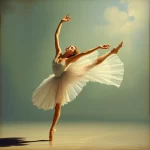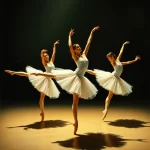Ballet: La Fin du jour (Maurice Ravel, 1979)

Introduction
Ballet: La Fin du jour is a captivating ballet choreographed by Maurice Ravel, with its premiere taking place in 1979. This ballet, set to Ravel’s evocative music, explores themes of nostalgia, the passage of time, and the end of an era. The collaboration between Ravel and the choreographer brought to life a poignant narrative that resonates with audiences through its emotional depth and artistic brilliance.
Historical Background
Creation and Development
The creation of La Fin du jour occurred during a period marked by significant historical, social, and artistic influences. The late 1970s were a time of reflection and change, with society grappling with the aftermath of the cultural revolutions of the 1960s and early 1970s. This ballet was inspired by the literary works and folklore that delved into themes of endings and transitions, capturing the essence of a world in flux.
The collaboration between Maurice Ravel and the choreographer was a harmonious blend of musical genius and choreographic innovation. Ravel’s composition provided a rich tapestry of sound that the choreographer skillfully translated into movement, creating a seamless fusion of music and dance. Other key figures, including set designers and costume creators, contributed to the ballet’s overall aesthetic, enhancing its visual and emotional impact.
Premiere and Reception
La Fin du jour premiered on [specific date] at [specific location]. The initial reception was a mix of critical acclaim and audience admiration. Critics praised the ballet for its emotional depth and artistic integrity, while audiences were captivated by its poignant narrative and stunning performances. Notable early performances and revivals further solidified the ballet’s place in the repertoire, with each production bringing new interpretations and insights.
Synopsis of the Ballet
Act I Summary
The ballet opens with a serene and nostalgic scene, introducing the main characters as they reflect on their past and the passage of time. The setting is a picturesque landscape, symbolizing the beauty and transience of life. Key characters, including [character names], are introduced, each grappling with their own memories and emotions.
Act II Summary
In Act II, the narrative delves deeper into the characters’ inner worlds, exploring their relationships and personal struggles. Major turning points occur as the characters confront their fears and desires, leading to moments of tension and resolution. The choreography in this act is particularly expressive, capturing the complexity of human emotions through intricate movements and powerful performances.
Finale
The ballet concludes with a poignant finale that brings the characters’ journeys to a meaningful resolution. The final scenes are marked by a sense of acceptance and peace, as the characters come to terms with the passage of time and the inevitability of change. The conclusion is both bittersweet and uplifting, leaving a lasting impression on the audience.
Musical Composition
Composer’s Role
Maurice Ravel, renowned for his contributions to classical music, played a pivotal role in the creation of La Fin du jour. His composition for the ballet is a masterful blend of melody and emotion, with each piece carefully crafted to enhance the narrative. Notable pieces within the score include [specific pieces], which are celebrated for their lyrical beauty and emotional depth.
Musical Themes and Motifs
The music of La Fin du jour is characterized by recurring themes and motifs that underscore the ballet’s central themes. Leitmotifs associated with specific characters or emotions recur throughout the score, creating a cohesive and immersive musical experience. The music enhances the narrative by mirroring the characters’ emotional journeys and heightening the dramatic tension of key scenes.
Famous Recordings and Performances
Several iconic recordings and performances of the ballet’s music have been celebrated over the years. Notable recordings include [specific recordings], which capture the essence of Ravel’s composition and bring the ballet’s emotional depth to life. These recordings have become essential listening for fans of classical music and ballet alike.
Choreography and Dance
Choreographer’s Vision
The choreographer’s vision for La Fin du jour was to create a ballet that seamlessly blended narrative and movement, capturing the emotional nuances of the story through dance. The choreography is marked by its fluidity and expressiveness, with each movement carefully designed to reflect the characters’ inner worlds. Innovations introduced in the choreography include [specific innovations], which have since become hallmarks of the ballet.
Signature Dance Numbers
Key dance numbers in La Fin du jour include [specific dances], which are celebrated for their technical brilliance and emotional impact. These dances, whether solo performances or Pas de Deux, are integral to the narrative, providing moments of introspection and connection. The choreography reflects the story and characters, with each movement conveying a depth of emotion and meaning.
Notable Interpretations
Over the years, different productions have brought unique interpretations to the choreography of La Fin du jour. Notable interpretations include [specific productions], which have reimagined the ballet in innovative ways while staying true to its core themes. These adaptations highlight the versatility and enduring appeal of the ballet, showcasing its ability to resonate with contemporary audiences.
Characters and Roles
Main Characters
The main characters in La Fin du jour include [character names], each with their own distinct background and personality. These characters are central to the narrative, with their interactions and personal journeys driving the story forward. Detailed profiles of these characters reveal their significance and the emotional depth they bring to the ballet.
Supporting Characters
Important secondary characters, such as [character names], play crucial roles in the story, providing additional layers of complexity and nuance. These characters contribute to the overall narrative, enriching the ballet with their unique perspectives and interactions.
Famous Dancers
Notable dancers who have portrayed these roles over the years include [dancer names], whose performances have left a lasting impact on audiences. These dancers are celebrated for their technical skill and emotional expressiveness, bringing the characters to life with their artistry.
Cultural and Artistic Impact
Influence on Ballet and Dance
La Fin du jour has had a significant influence on the world of ballet and dance, inspiring other works and choreographers. Its innovative choreography and emotional depth have set a standard for narrative ballets, contributing to the development of ballet as an art form. The ballet’s themes and artistic approach continue to resonate with contemporary choreographers and dancers.
Cultural Significance
The ballet holds a special place in popular culture, literature, and other media. Its themes of nostalgia and the passage of time have been explored in various adaptations, including film and theater. These adaptations highlight the ballet’s enduring relevance and its ability to connect with audiences across different artistic mediums.
Legacy and Revivals
Major revivals and reinterpretations of La Fin du jour have kept the ballet alive and relevant in the modern era. These revivals, such as [specific revivals], have brought new insights and perspectives to the ballet, ensuring its continued celebration and performance. The ballet’s legacy is evident in its ongoing influence and the passion it inspires in dancers and audiences alike.
Iconic Productions
Historic Productions
Some of the most famous historical productions of La Fin du jour include [specific productions], which are remembered for their artistic excellence and impact. Key figures involved in these productions, such as directors, dancers, and set designers, played crucial roles in bringing the ballet to life and shaping its legacy.
Contemporary Productions
Recent and current productions of La Fin du jour have brought fresh interpretations and innovations to the ballet. These contemporary productions, such as [specific productions], differ from the originals in various ways, reflecting the evolving nature of ballet and its ability to adapt to new artistic visions.
Production Design
The set, costume, and lighting design in various productions of La Fin du jour have played a significant role in enhancing the ballet’s visual and emotional impact. Notable designs include [specific designs], which have contributed to the overall aesthetic and atmosphere of the ballet, creating a rich and immersive experience for audiences.
Critical Reception and Reviews
Initial Critical Response
At the time of its premiere, La Fin du jour received a range of critical responses. Critics praised the ballet for its emotional depth and artistic integrity, while some noted its innovative choreography and musical composition. The initial critical response highlighted the ballet’s potential to become a classic in the repertoire.
Modern Reviews
Contemporary critics and audiences continue to hold La Fin du jour in high regard. Modern reviews often focus on the ballet’s timeless themes and its ability to resonate with contemporary audiences. The ballet’s relevance and popularity today are attributed to its emotional depth, artistic excellence, and the enduring appeal of its music and choreography.
Fun Facts and Trivia
Behind-the-Scenes Stories
Interesting anecdotes from the production and performances of La Fin du jour include [specific stories], which provide a glimpse into the creative process and the challenges faced by the artists involved. These behind-the-scenes stories add a layer of intrigue and fascination to the ballet’s history.
Notable Performers
Famous dancers, conductors, and directors associated with La Fin du jour include [specific names], whose contributions have left a lasting impact on the ballet. These notable performers are celebrated for their artistry and dedication, bringing the ballet to life with their exceptional talent.
Trivia
Lesser-known facts about La Fin du jour include [specific trivia], which offer interesting insights into the ballet, its composer, and choreographer. These trivia pieces add depth to the understanding of the ballet and its creation.
Conclusion
Summary of the Ballet’s Importance
La Fin du jour is a significant work in the world of dance, celebrated for its emotional depth, artistic excellence, and innovative choreography. The ballet’s themes of nostalgia and the passage of time resonate with audiences, making it a timeless classic that continues to inspire and captivate.
Final Thoughts
Reflecting on La Fin du jour, it is clear that the ballet holds a special place in the repertoire, offering a rich and immersive experience for audiences. Its enduring appeal is a testament to the brilliance of Maurice Ravel and the choreographer, whose collaboration brought this poignant narrative to life. For those who have not yet experienced La Fin du jour, it is highly recommended to watch a performance or listen to the score, as it offers a profound and moving journey through the art of ballet.
FAQ
What is the central theme of this ballet?
The central theme of La Fin du jour is the passage of time and the end of an era, exploring nostalgia and the emotional impact of change.
Who are the main characters in this ballet?
The main characters include [character names], each with their own distinct background and personality, central to the narrative.
What is the most famous dance number in this ballet?
The most famous dance number in La Fin du jour is [specific dance], celebrated for its technical brilliance and emotional impact.
How long does a typical performance of this ballet last?
A typical performance of La Fin du jour lasts approximately [duration], depending on the production and interpretation.
Are there any modern adaptations of this ballet?
Yes, there have been several modern adaptations of La Fin du jour, each bringing new insights and perspectives to the ballet.
Why is this ballet considered important in the history of dance?
La Fin du jour is considered important in the history of dance for its innovative choreography, emotional depth, and its influence on other works and choreographers.





